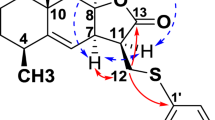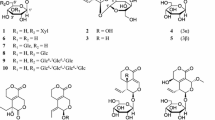Abstract
Thirty dihydroflavonol derivatives (D1–D30) were designed and synthesized, meanwhile the synthesized compounds were characterized on the basis of spectroscopic analyzes. Their inhibitory activity against the pro-inflammatory inducible interleukin-1β (IL-1β), interleukin-6 (IL-6), and tumor necrosis factor-α (TNF-α) in lipopolysaccharide (LPS)-stimulated murine RAW 264.7 macrophages were evaluated and showed various efficiency. Compounds D1–D30 showed no toxic effects on RAW 264.7 cells at the concentration 20 μM; among them, compounds D9, D13, and D19 exhibited best anti-inflammatory activity through decreasing IL-1β, IL-6, and TNF-α. Furthermore, their structure–activity relationships were discussed preliminarily.







Similar content being viewed by others
References
Bengmark S (2006) Curcumin, an atoxic antioxidant and natural nfkappab, cyclooxygenase-2, lipooxygenase, and inducible nitric oxide synthase inhibitor: a shield against acute and chronic diseases. J Parenter Enter Nutr 1:45–51
Cho BO, Ryu HW, So Y, Cho JK, Woo HS, Jin CH, Baek JY, Park KH, Byun EH, Jeong IY (2013) Anti-inflammatory effect of austroinulin and 6-o-acetyl-austroinulin from stevia rebaudiana in lipopolysaccharide-stimulated RAW264.7 macrophages. Food Chem Toxicol 12:638–644
Dok-Go H, Lee KH, Kim HJ, Lee EH, Lee J, Song YS, Lee YH, Jinb C, Lee YS, Choa J (2003) Neuroprotective effects of antioxidative flavonoids, quercetin, (+)-dihydroquercetin and quercetin 3-methyl ether, isolated from opuntia ficus-indica var. saboten. Brain Res 1–2:130–136
Guan LP, Zhao DH, Chang Y, Wen ZS, Tang LM, Huang FF (2013) Synthesis of 2,4-dihydroxychalcone derivatives as potential antidepressant effect. Drug Res 63:46–51
Hanelt M, Gareis M, Kollarczik B (1994) Cytotoxicity of mycotoxins evaluated by the MTT-cell culture assay. Mycopathologia 3:167–174
Hernández V, Recio MC, Máñez S, Giner RM, Ríos JL (2007) Effects of naturally occurring dihydroflavonols from inula viscosa on inflammation and enzymes involved in the arachidonic acid metabolism. Life Sci 6:480–488
Jiang WJ, Ishiuchi K, Furukawa M, Takamiya T, Kitanaka S, Iijima H (2015) Stereospecific inhibition of nitric oxide production in macrophage cells by flavanonols: synthesis and the structure–activity relationship. Bioorg Med Chem 23:6922–6929
Kim YJ, Choi SE, Lee MW, Lee CS (2008) Taxifolin glycoside inhibits dendritic cell responses stimulated by lipopolysaccharide and lipoteichoic acid. J Pharm Pharmacol 11:1465–1472
Lu CL, Zhu YF, Hu MM, Wang DM, Xu XJ, Lu CJ, Zhu W (2015) Optimization of astilbin extraction from the rhizome of smilax glabra, and evaluation of its anti-inflammatory effect and probable underlying mechanism in lipopolysaccharide-induced RAW264.7 macrophages. Molecules 1:625–644
Manigandan K, Manimaran D, Jayaraj RL, Elangovan N, Dhivya V, Kaphle A (2015) Taxifolin curbs nf-κb-mediated wnt/β-catenin signaling via up-regulating nrf2 pathway in experimental colon carcinogenesis. Biochimie 119:103–112
Mantovani A, Allavena P, Sica A, Balkwill F (2008) Review article cancer-related inflammation. Nature 7203:436–444
Marín M, Giner RM, Recio MC, Máñez S (2011) Phenylpropanoid and phenylisoprenoid metabolites from asteraceae species as inhibitors of protein carbonylation. Phytochemistry 14:1821–1825
Pelter A, Ward RS, Gray TI (1976) The carbon-13 nuclear magnetic resonance spectra of flavonoids and related compounds. J Chem Soc Perkin Trans 1(8):2475–2483
Ragab EA, Raafat M (2016) A new monoterpene glucoside and complete assignments of dihydroflavonols of pulicaria jaubertii: potential cytotoxic and blood pressure lowering activity. Nat Prod Res 11:1280–1288
Raison CL, Capuron L, Miller AH (2006) Cytokines sing the blues: inflammation and the pathogenesis of depression. Trends Immunol 1:24–31
Siemieniuch MJ, Szóstek AZ, Gajos K, Kozdrowski R, Nowak M, Okuda K (2016) Type of inflammation differentially affects expression of interleukin 1β and 6, tumor necrosis factor-α and toll-like receptors in subclinical endometritis in mares. PLoS One 5:e0154934
Slade D, Ferreira D, Marais JPJ (2005) Circular dichroism, a powerful tool for the assessment of absolute configuration of flavonoids. Phytochemistry 1:2177–2215
Sudsai T, Prabpai S, Kongsaeree P, Wattanapiromsakul C, Tewtrakul S (2014) Anti-inflammatory activity of compounds from boesenbergia longiflora rhizomes. J Ethnopharmacol 2:453–461
Sui X, Quan YC, Chang Y, Zhang RP, Xu YF, Guan LP (2012) Synthesis and studies on antidepressant activity of 2′,4′,6′-trihydroxychalcone derivatives. Med Chem Res 21:1290–1296
Sun LP, Gao LX, Ma WP, Nan FJ, Li J, Piao HR (2012) Synthesis and biological evaluation of 2,4,6-trihydroxychalcone derivatives as novel protein tyrosine phosphatase 1b inhibitors. Chem Biol Drug Des 4:584–590
Swaminathan P, Kalva S, Saleena LM (2014) E-pharmacophore and molecular dynamics study of flavonols and dihydroflavonols as inhibitors against dihydroorotate dehydrogenase. Comb Chem High Throughput Screen 8:663–673
Terrier N, Poncet-Legrand C, Cheynier V (2009) Flavanols, flavonols and dihydroflavonols. Wine Chem Biochem 5:463–507
Vezza T, Rodrígueznogales A, Algieri F, Utrilla MP, Rodriguezcabezas ME, Galvez J (2016) Flavonoids in inflammatory bowel disease: a review. Nutrients 8:211
Wang QQ, Shi JB, Chen C, Huang C, Tang WJ, Li J (2016) Hesperetin derivatives: synthesis and anti-inflammatory activity. Bioorg Med Chem Lett 5:1460–1465
Xie C, Shen CJ, Chen SH, Ye XC, Zou PC, Liu YW (2012) Study on serum pharmacochemistry of anti-inflammatory active site in Smilax China L. Her Med 31:288–291
Zhang Y, Zhao L, Wu J, Jiang X, Dong L, Xu F, Zou P, Dai Y, Shan X, Yang S, Liang G (2014) Synthesis and evaluation of a series of novel asymmetrical curcumin analogs for the treatment of inflammation. Molecules 6:7287–7307
Zhou ZB, Wang H, Tao KQ, Ye XC, Hu CL (2016) A facile method to prepare dihydroflavonol derivatives. Chin J Org Chem 11:2752–2756
Acknowledgements
The authors would like to extend their sincere appreciation to the National Natural Science Foundation of China for funding this research group (NO. 31370378).
Author information
Authors and Affiliations
Corresponding author
Ethics declarations
Conflict of interest
The authors declare that they have no competing interests.
Additional information
Chunling Hu and Zongbao Zhou contributed equally to this work.
Rights and permissions
About this article
Cite this article
Hu, C., Zhou, Z., Xiang, Y. et al. Design, synthesis and anti-inflammatory activity of dihydroflavonol derivatives. Med Chem Res 27, 194–205 (2018). https://doi.org/10.1007/s00044-017-2054-z
Received:
Accepted:
Published:
Issue Date:
DOI: https://doi.org/10.1007/s00044-017-2054-z




